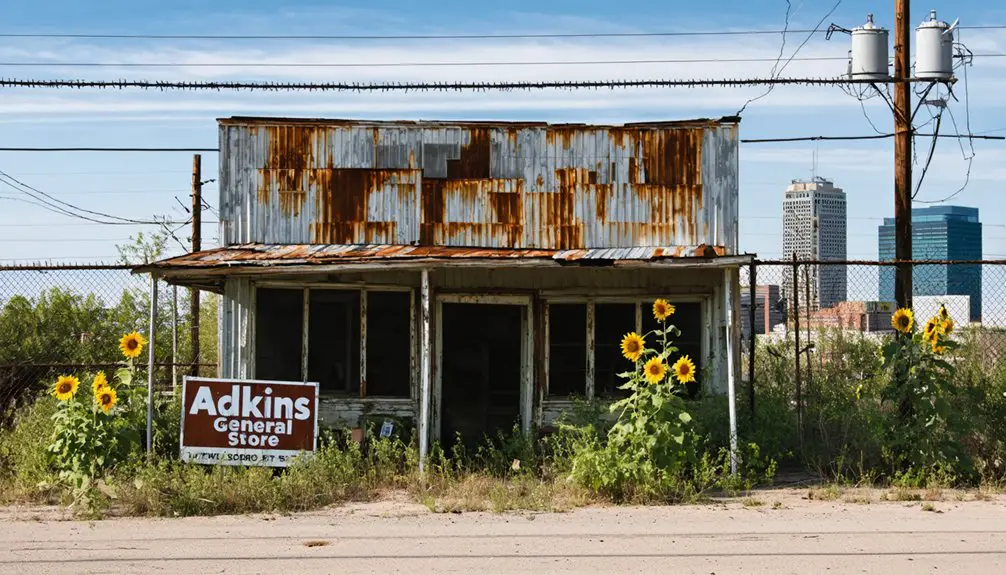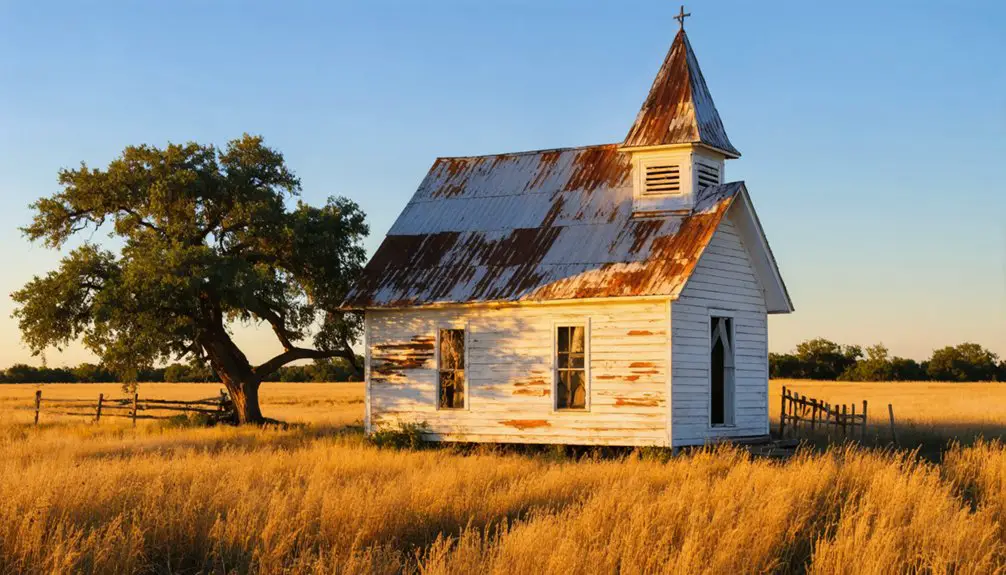You’ll find Adkins, Texas – a ghost town with an active population – fourteen miles east of San Antonio. Established in the 1880s as a railway flag station, it grew from 100 residents in 1910 to 241 by 1990. The town features historic structures, including the original railway depot location and four 1940s business sites. Local legends tell of paranormal activity, mysterious shadows, and phantom train whistles that echo through this transformed commuter community.
Key Takeaways
- Adkins transformed from an 1880s railway flag station into a ghost town, though it maintains a small population of 241 residents.
- The community experienced early decline due to a boll weevil infestation that devastated local cotton production in the early 1900s.
- Four historic business locations from the 1940s and various abandoned homesites remain as evidence of the town’s past.
- Local paranormal activity includes mysterious phenomena at an elderly woman’s house and ghostly sightings at the old railway station.
- Despite its ghost town status, Adkins has evolved into a commuter community due to its proximity to San Antonio.
Origins of a Railway Flag Station
While many Texas towns emerged from frontier settlements, Adkins began in the 1880s specifically as a flag station along the Galveston, Harrisburg and San Antonio Railway line.
You’ll find it fourteen miles east of downtown San Antonio in eastern Bexar County, where William Adkins Jones donated land for the depot and switchyard that would become the community’s cornerstone.
Unlike regular stops, this flag station operated on an as-needed basis – trains would only stop when signaled, a common practice for serving rural areas.
The railway’s presence sparked initial settlement and growth in the area, with the station becoming a crucial link in Texas’ expanding transportation network. This historical site represents part of Texas’s rich heritage that continues to fascinate visitors and locals alike.
The area features a blend of rural landscapes typical of Central Texas, offering visitors a glimpse into the region’s natural beauty.
The establishment of the flag station marked the beginning of Adkins’ role in regional railway growth, connecting smaller localities to larger markets and hubs.
Early Settlement and Growth
Three key factors drove Adkins’ early settlement and growth: agricultural prospects, railway access, and land availability.
You’ll find that William Adkins Jones’ land donation for the depot and switchyard kickstarted the community’s establishment, while the fertile rolling prairies attracted settlers seeking cotton farming opportunities.
Settlement patterns reflected the era’s broader migration trends, with families primarily arriving from Southern states like Georgia and Mississippi. Like in nearby towns, the boll weevil infestation devastated local cotton production, costing farmers millions in lost crops.
Southern families from Georgia and Mississippi followed migration patterns common to the era, establishing new roots in unfamiliar territory.
The agricultural influences shaped early development, as large land purchases – including an 8,000-acre tract near Cheapside – defined the region’s character.
By 1910, you’d have found a thriving community of 100 residents, complete with two churches and a school. The town’s decline began as transportation methods shifted away from rail dependence.
The railway flag station‘s presence enhanced settlement viability, connecting local farmers and merchants to wider markets.
Between Ghost Town and Historic Community
Despite its classification as a ghost town, Adkins straddles a unique position between abandonment and liveliness.
You’ll find a community that’s weathered significant changes, from its peak of 150 residents in 1940 to a surprising growth of 241 by 1990, alongside 32 businesses. This growth, largely influenced by San Antonio’s urban expansion and Loop 1604’s construction, sets Adkins apart from typical ghost towns. Just as the silver mine closure contributed to other Texas ghost towns’ decline, Adkins faces its own economic challenges.
The community challenges facing Adkins mirror those of other shifting towns in Texas. Like many communities facing rural depopulation trends, aging ranching families are selling their land and moving away.
While some preservation initiatives help maintain its historical identity, you’re witnessing a place that’s neither fully abandoned nor completely thriving.
It’s part of a broader pattern where railway-founded communities adapt to modern transportation shifts, either integrating into suburban growth or fading into historical obscurity.
Local Legends and Haunted Tales
Among Adkins’ most chilling legends is the tale of a reclusive elderly woman’s house, where paranormal investigators have documented unexplained phenomena linked to alleged demonic rituals from the early 20th century.
You’ll find the property’s exact location carefully guarded by locals, though witness accounts describe shadowy figures, mysterious sounds, and an oppressive atmosphere that’s drawn ghost hunters from across Texas. Like many of Texas’s 511 ghost towns, Adkins holds secrets waiting to be uncovered by curious visitors. Residents frequently report seeing burnt words appear mysteriously on their ceilings, often spelling out ominous messages.
The old railway station, where Adkins first took root in the 1880s, adds another layer to the town’s haunted reputation, with reports of spectral passengers and phantom train whistles echoing through the night.
Demonic House Mysteries
While Adkins’ decline as a railway town forms its historical foundation, local legends surrounding a mysterious derelict house have shaped the community’s supernatural reputation. Similar to Toyah’s haunted reputation, the town has cultivated an air of supernatural mystery.
You’ll find whispered tales of an elderly woman who allegedly performed demonic rituals within its walls, drawing unsuspecting visitors under her occult influence. The house’s exact location remains undisclosed in public records, adding to its mystique among paranormal enthusiasts. Metal detector enthusiasts often consult historical maps to explore the area’s secrets.
The haunted legends have spawned reports of shadowy figures and unexplained sounds throughout Adkins.
Though these accounts lack formal documentation, they’ve become deeply woven into the area’s folklore. While no institutional investigations confirm the stories of demonic activities, the abandoned structure continues to intrigue ghost town explorers seeking evidence of supernatural phenomena in this semi-deserted Texas community.
Paranormal Railway Stories
Beyond Adkins’ railroad heritage lies a web of paranormal tales centered on nearby tracks in San Antonio, roughly 14 miles away. The tracks have become legendary for reported spectral sightings of ghost children, with witnesses describing unexplained voices, laughter, and mysterious handprints appearing on vehicles.
While official records don’t confirm any local accidents, visitors continue leaving offerings at the site, creating a powerful blend of folklore and spiritual tradition.
Here’s what makes these railway stories particularly compelling:
- Cars reportedly move uphill on their own along the tracks
- Children’s handprints materialize on vehicle surfaces
- Distinct sounds of young voices echo near the rails
- Religious items and toys are left as spiritual offerings
These unexplained phenomena have transformed this stretch of track into a significant piece of local paranormal lore.
San Antonio’s Urban Influence

You’ll find that San Antonio’s urban expansion has dramatically transformed Adkins from its rural roots into a commuter-oriented community, as evidenced by its population growth from 100 residents in 1910 to 241 by 1990.
The construction of Loop 1604 and improved transportation infrastructure strengthened Adkins’ connection to San Antonio’s metropolitan area, spurring the development of 32 businesses by 1990.
The community’s evolution reflects the broader pattern of San Antonio’s suburban growth, with former railway stops like Adkins becoming integrated into the city’s expanding orbit through enhanced road networks and economic opportunities.
Urban Growth Drives Change
As San Antonio’s population surges toward 1.53 million in 2024, its urban influence continues reshaping surrounding communities and suburbs.
You’ll witness this transformation through steady urban migration and suburban sprawl, driven by the city’s robust 1.25-1.7% annual growth rate.
The metro area’s evolution is marked by these key changes:
- Job growth hitting 2.5% annually with average wages climbing to $31.53/hour
- Population expanding by 23,900 residents in just one year
- Real estate market adjusting with a projected 4% price decline
- Infrastructure demands intensifying across transportation and utilities
You’re seeing a dynamic shift as San Antonio’s growth ripples outward, transforming quiet suburbs while maintaining its position as Texas’s seventh-largest city, despite recent cooling in the historically strong growth rate.
Commuter Town Evolution
While Adkins began as a modest flag station in the 1880s, its transformation into a commuter town showcases San Antonio’s expanding metropolitan influence.
You’ll find that Adkins’ evolution accelerated when Loop 1604’s construction improved access to San Antonio, making the commuter lifestyle more feasible for residents.
The town’s growth patterns reflect this suburban development, with population rising from 100 in 1910 to 241 by 1990.
Business establishments increased from 4 to 32 during this period, shifting from railway-focused services to meeting commuter needs.
The town’s proximity to downtown San Antonio – just 14 miles – has made it an attractive option for those seeking a balance between city employment and small-town living.
Infrastructure improvements, including enhanced utilities and schools, have supported this transformation.
Historic Sites and Exploration
Modern-day explorers and history enthusiasts can discover several key historic landmarks throughout Adkins, Texas, including the original railway depot location and remnants of early 20th-century structures.
The town’s layout, documented in historical maps, reveals prime locations for exploration activities and metal detecting opportunities.
You’ll find these notable sites worthy of investigation:
- The original railway depot and switchyard site donated by William Adkins Jones
- Remnants of two early churches and the community school from the 1910 era
- Four historic business locations dating back to the 1940s
- Various abandoned homesites scattered throughout the area
While there aren’t any formally preserved structures, you can still trace Adkins’ past through its ruins, making it an authentic destination for ghost town enthusiasts and photographers seeking undisturbed historical sites.
Frequently Asked Questions
Are There Any Remaining Original Structures From the 1880S Railway Station?
You won’t find any original railway station architecture from the 1880s standing today, as historical preservation efforts haven’t documented surviving structures from Adkins’ early depot and switchyard operations.
What Happened to William Adkins Jones’s Family After Founding the Town?
You won’t find detailed records of the Jones descendants’ stories, as historical documents don’t track the Adkins family legacy beyond William’s initial role in founding the town through land donation.
How Did the Great Depression Impact Adkins’ Population and Businesses?
Despite dramatic economic decline, you’ll find the population paradoxically grew from 100 to 150, though businesses dropped to just four by 1940, showing remarkable community resilience despite Depression-era hardships.
What Native American Tribes Originally Inhabited the Adkins Area?
You’ll find the Coahuiltecans were the earliest native tribes in the area, followed by Comanches, Apaches, Tonkawas, and Caddos, each contributing to the region’s rich cultural heritage through time.
Where Can Visitors Park to Explore the Historical Sites Today?
Like finding a WiFi signal in 1885, visitor parking isn’t officially designated. You’ll need to use the Bronco Parking lot along US Hwy 87 E or informal roadside spots near historical sites.
References
- https://www.hipcamp.com/journal/camping/texas-ghost-towns/
- https://www.tshaonline.org/handbook/entries/adkins-tx
- https://texashighways.com/travel-news/four-texas-ghost-towns/
- https://www.ghostsofamerica.com/7/Texas_Adkins_ghost_sightings.html
- https://pastmaps.com/explore/us/texas/bexar-county/adkins/metal-detecting
- https://en.wikipedia.org/wiki/List_of_ghost_towns_in_Texas
- https://www.texasescapes.com/EastTexasTowns/Hawkins-Texas.htm
- https://en.wikipedia.org/wiki/Adkins
- https://www.loquis.com/en/loquis/6414388/Adkins+Texas
- https://losttexasroads.com/history/places/kicaster-tx/



